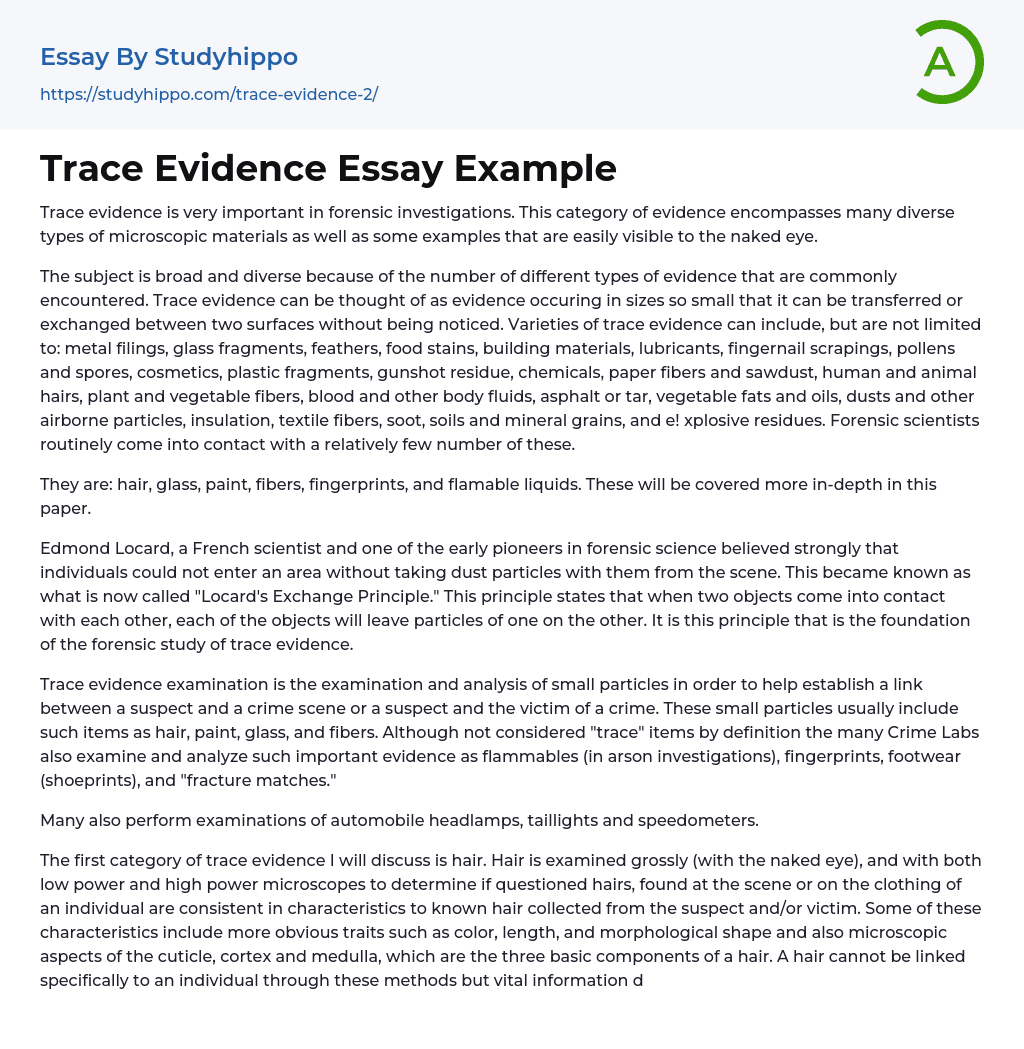Trace evidence plays a crucial role in forensic investigations, encompassing various microscopic materials and visible examples. Due to the wide range of commonly encountered evidence types, the subject is diverse. Trace evidence consists of tiny particles that can be transferred unnoticed between surfaces. Examples include metal filings, glass fragments, feathers, food stains, building materials, lubricants, fingernail scrapings, pollens and spores, cosmetics, plastic fragments, gunshot residue, chemicals, paper fibers and sawdust, human and animal hairs, plant and vegetable fibers, blood and other body fluids, asphalt or tar, vegetable fats and oils, dusts and airborne particles, insulation, textile fibers, soot, soils and mineral grains, and explosive residues. Forensic scientists regularly encounter only a few of these varieties.
These include hair, glass, paint, fibers, fingerprints, and flammable liquids.
...This paper will delve deeper into these specific categories. Edmond Locard, a French scientist and pioneer in forensic science, strongly believed that individuals inevitably carry dust particles from the scene when they enter an area.
This gave rise to what is now known as "Locard's Exchange Principle," which states that when two objects come into contact, they leave particles of one on the other. This principle forms the basis of trace evidence examination in forensics, which involves analyzing small particles to establish links between suspects, crime scenes, and victims. These particles typically include hair, paint, glass, and fibers. Crime labs also examine other crucial evidence like flammables, fingerprints, footwear, and fracture matches. Furthermore, they may also examine automobile headlamps, taillights, and speedometers. The first category of trace evidence is hair, which is scrutinized visually and with microscopes to determine if it matches known samples from suspect
and/or victims. Characteristics examined include color, length, shape, cuticle, cortex, and medulla.Through forensic analysis, it is possible to gather valuable information about a suspect using hair evidence. While it may not provide specific identification, attributes such as race, sex, body region, and even an estimate of the last haircut can be determined. Another type of trace evidence, glass, can also be utilized in linking a suspect to a crime scene. When larger samples are available, "fracture matches" can be performed by physically fitting pieces of glass from the crime scene with those associated with the suspect. Even tiny fragments of glass found on a perpetrator's clothing can be examined under a microscope and characterized using "refractive index" determination. This measurement assesses how light is bent as it passes through the microscopic glass sample, providing further insight into its composition and purpose.Samples can be compared to determine if the glass from the crime scene could match the glass found on the suspect's clothes. Paint is another type of trace evidence that can be collected during burglaries or car collisions. Forensic Scientists conduct tests on these samples, even if they are small in size. These tests involve low power magnification to determine color, layer sequence, thickness, and texture of the paint. If the questioned and known paint samples appear similar, analytical chemical and instrumental examinations are conducted. These tests provide further characterization of the paints to determine if they have a common origin. Fiber examination is another type of trace evidence that focuses on the transfer of clothing fibers between individuals or between a suspect and the environment at a crime scene. Similar to paint analysis, questioned
and known fibers are examined and compared using microscopic and analytical instrumental techniques.Fiber analysis is a valuable tool in criminal investigations and prosecutions. While individual fibers cannot be definitively linked to a specific garment or fabric, finding fibers with similar characteristics (composition, color, shade, and shape) on a suspect, alongside known fibers from the crime scene, can provide significant evidence. In fact, fiber analysis has often revealed that a person's body was likely transported in a car trunk. Arson investigators also rely on trace evidence, specifically flammable liquids, to determine if a fire was intentionally started. By collecting samples from the burned area and submitting them for analysis, arson examinations can determine if accelerants were used. Even tiny amounts of petroleum residues can be found in burned debris, which supports the argument that deliberate arson took place. Lastly, fingerprints are another form of trace evidence that can be examined by forensic scientists. They analyze items submitted to them and process crime scenes in order to locate usable fingerprints.
The labs utilize traditional fingerprint methods such as dusting powders, ninhydrin solutions, and "Superglue" techniques. They also employ advanced detection technology like laser lighting and computer enhanced imaging. These modern techniques are especially useful for examining faint latent prints, smudged prints, prints on multicolored surfaces, and blurry surveillance photos. They are also valuable in analyzing other photos that would otherwise be considered useless. Trace evidence plays a significant role in forensic science and is crucial for identifying criminals. One of the greatest advantages of trace evidence is that its deposition often goes unnoticed. However, its importance should not be underestimated, as demonstrated in the article. Various
scientific techniques are used to analyze trace evidence, as shown above.
- Organic Chemistry essays
- Acid essays
- Calcium essays
- Chemical Bond essays
- Chemical Reaction essays
- Chromatography essays
- Ethanol essays
- Hydrogen essays
- Periodic Table essays
- Titration essays
- Chemical reactions essays
- Osmosis essays
- Carbohydrate essays
- Carbon essays
- Ph essays
- Diffusion essays
- Copper essays
- Salt essays
- Concentration essays
- Sodium essays
- Distillation essays
- Amylase essays
- Magnesium essays
- Acid Rain essays
- Agriculture essays
- Albert einstein essays
- Animals essays
- Archaeology essays
- Bear essays
- Biology essays
- Birds essays
- Butterfly essays
- Cat essays
- Charles Darwin essays
- Chemistry essays
- Dinosaur essays
- Discovery essays
- Dolphin essays
- Elephant essays
- Eli Whitney essays
- Environmental Science essays
- Evolution essays
- Fish essays
- Genetics essays
- Horse essays
- Human Evolution essays
- Isaac Newton essays
- Journal essays
- Linguistics essays
- Lion essays




